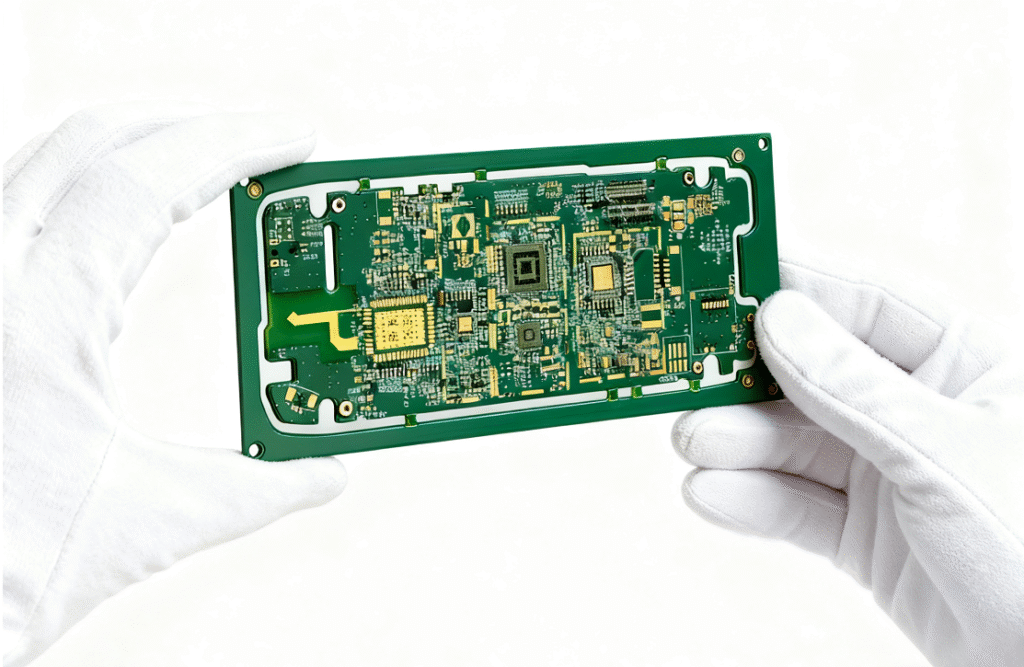Controlled Impedance for High-Frequency PCBs
Controlled Impedance for High-Frequency PCBs : by precisely designing a circuit board’s wiring shape, materials and other details. The wires on the board (like various conductors) maintain a fixed “resistance value” (such as preset numbers like 50Ω or 75Ω) when transmitting high-frequency signals.
The goal is to keep the “resistance consistent” during signal transmission, reduce signal bounce, loss, or distortion, and let high-frequency signals pass through smoothly.

1. Why is Impedance Control Required for High-Frequency PCBs?
Maintaining data and signal integrity is critical in high-frequency PCBs. In low-frequency circuits, impedance matching has little impact on performance. However, when signal frequency increases (typically ≥1GHz, such as RF, microwave, and high-speed digital signals), the “wave-particle duality” of signals becomes prominent — signals are no longer pure current/voltage but propagate as electromagnetic waves in transmission lines. Controlled impedance helps preserve data integrity and signal clarity.
Sudden changes in transmission line impedance (e.g., abrupt line width variations, uneven dielectric materials, mismatched connector interfaces) cause signal reflection (partial energy bounces back to the transmitter), leading to signal jitter, superimposed interference, or even transmission failure.
Impedance mismatch also increases transmission losses (e.g., insertion loss, return loss) and degrades Signal Integrity (SI). Therefore, high-frequency PCBs (used in 5G base stations, radar, satellite communications, high-speed servers, etc.) must adopt “controlled impedance” design to ensure consistent impedance from the transmitter to the receiver, maximizing signal transmission efficiency.

2. What are the Key Factors Affecting Controlled Impedance?
The characteristic impedance of a transmission line is determined by the PCB’s physical parameters and material properties. Core factors include:
Transmission Line Geometry
- Conductor width: Wider lines result in lower impedance.
- Conductor thickness: Thicker copper foil leads to lower impedance.
- Distance between the conductor and reference plane (e.g., ground plane): Thicker dielectric layers cause higher impedance.
- Differential pair spacing: Larger spacing increases differential impedance.
Dielectric Material Properties
- Dielectric constant (εr): A parameter of material insulation performance; higher εr leads to lower impedance (common high-frequency materials: PTFE with εr≈2.1, FR-4 with εr≈4.2-4.7).
- Dielectric loss tangent (tanδ): Affects signal loss; low tanδ materials (e.g., Rogers RO4350) are preferred for high-frequency applications.
Process Precision
- Etching accuracy: Line width errors directly cause impedance deviations.
- Lamination thickness control: Dielectric thickness variations significantly impact impedance.
- Copper foil surface roughness: Skin effect is pronounced at high frequencies; excessive roughness increases losses.
3. What are the Common Impedance Standards and Their Applications?
Different high-frequency devices have varying impedance requirements, with universal industry values:
- 50Ω: Used in antennas, radar, and RF modules; balances signal transmission power and loss.
- 75Ω: Applied in HDMI cables, TV signals, and broadcast equipment; suitable for video transmission.
- 100Ω: Used in USB, Ethernet, and high-speed data interfaces (e.g., PCIe); reduces signal interference.
- Special values: 25Ω for high-power transmission, 150Ω for specific scenarios; customizable per customer requirements.
4. How to Achieve and Test Controlled Impedance?
Design Phase
Use professional software (e.g., Polar, Cadence) to calculate impedance values by inputting material parameters and line dimensions. Ensure the error from the target value does not exceed 10% (≤5% for high-end applications).
Production Phase
- Maintain material consistency, such as stable quality across PCB batches.
- Ensure precise line etching and lamination: line width error ≤0.02mm, dielectric thickness error ≤5%.
- “Pre-enlarge line width” for high-frequency scenarios to offset shrinkage during production (called “impedance compensation”).
Testing Phase
Use TDR (Time Domain Reflectometer) or network analyzers to measure actual impedance and check signal reflection. Ensure impedance meets standards for each PCB batch.

